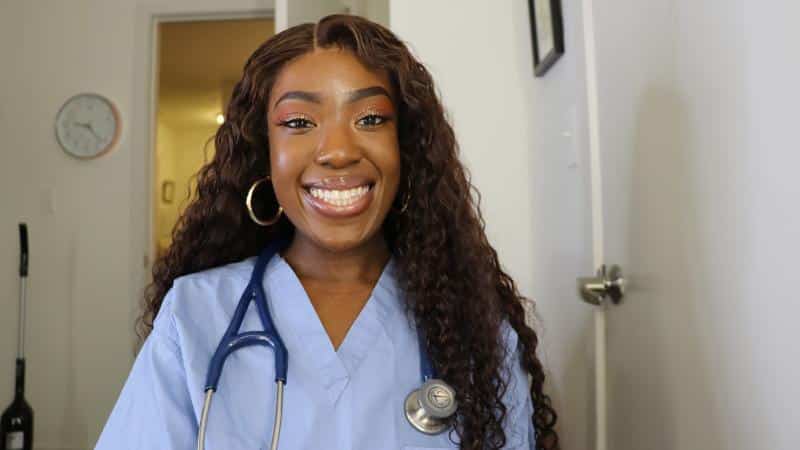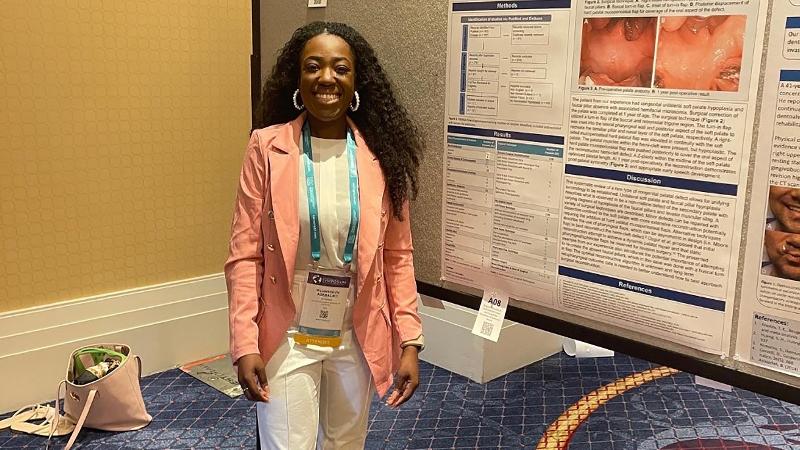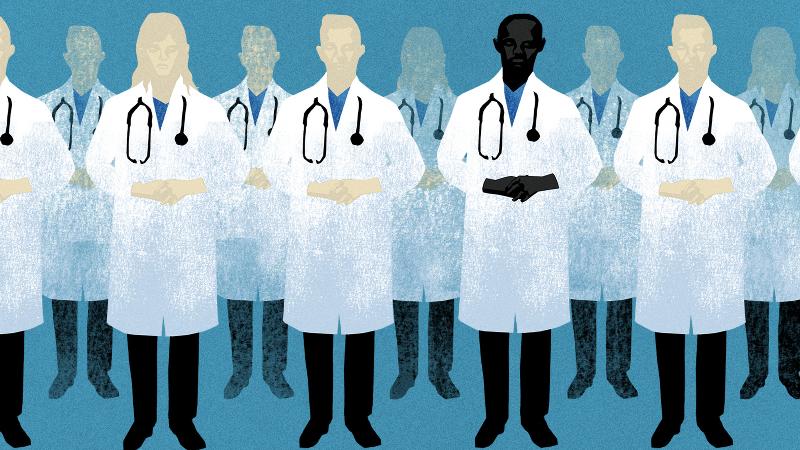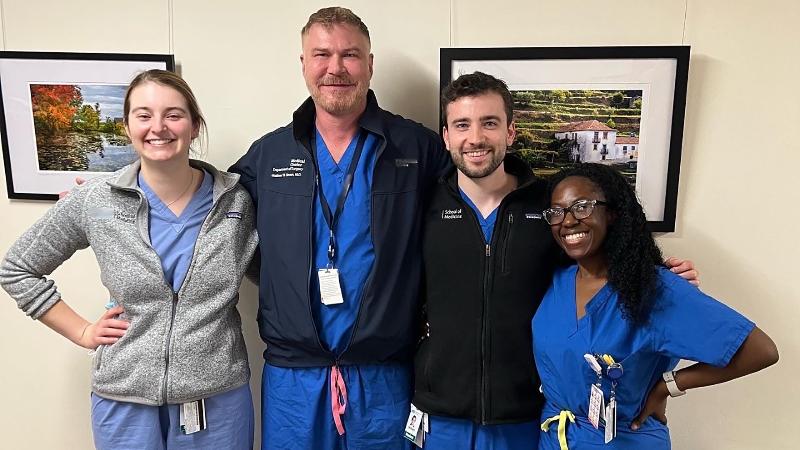
*(CNN) — When being truly honest with herself, Seun Adebagbo says, she can describe what drove her to go to medical school in a single word: self-preservation.
Adebagbo, who was born in Nigeria and grew up in Boston, said that as a child, she often saw tensions between certain aspects of Western medicine and beliefs within Nigerian culture. She yearned to have the expertise to bridge those worlds and help translate medical information while combating misinformation — for her loved ones and for herself.
“I wanted to go into medicine because I felt like, ‘Who better to mediate that tension than someone like me, who knows what it’s like to exist in both?’ ” said Adebagbo, 26, who graduated from Stanford University and is now a third-year medical school student in Massachusetts.
“The deeper I got into my medical education, the more I realized, if I’m in the system, I know how it works. I not only know the science, but I also know how the system works,” she said of how in many Black and brown communities, there can be limited access to care and resources within the medical system.
This has enabled Adebagbo to connect with patients of color in her rotations. She recognizes that their encounters with her are brief, she said, and so she tries to empower them to advocate for themselves in the health system.
MORE NEWS ON EURWEB: Fat Joe Slams Father of Ja Morant for Getting Drunk at Games Instead of Parenting His Son | WATCH

“I know what to ask for on the patient side if I’m worried about something for myself. But then also, for my parents and my family,” Adebagbo said. “Because the way you have to move in the system as a Black person is very different, especially if you’re coming from a background where you don’t have family members that are doctors, you don’t know anyone in your periphery that went into medicine.”
Only about 5.7% of physicians in the United States identify as Black or African American, according to the the latest data from the Association of American Medical Colleges. This statistic does not reflect the communities they serve, as an estimated 12% of the US population is Black or African American.
And while the proportion of Black physicians in the US has risen over the past 120 years, some research shows, it’s still extremely low.
One reason why the percentage of US doctors who are Black remains far below that of the US population that is Black can be traced to how Black people have been “historically excluded from medicine” and the “institutional and systemic racism in our society,” said Michael Dill, the Association of American Medical Colleges’ director of workforce studies.
“And it occurs over the course of what I think of as the trajectory to becoming a physician,” Dill said. At young ages, exposure to the sciences, science education resources, mentors and role models all make it more likely that a child could become a doctor — but such exposures and resources sometimes are disproportionately not as accessible in the Black community.
“We can improve our admissions to medical school, make them more holistic, try to remove bias from that, but that’s still not going to solve the problem,” Dill said.
“We need to look at which schools produce the most medical students and figure out how we improve the representation of Black students in those schools,” he said. “That requires going back to pre-college — high school, middle school, elementary school, kindergarten, pre-K — we need to do better in all of those places in order to elevate the overall trajectory to becoming a physician and make it more likely that we will get more Black doctors in the long run.”
A deep-rooted history of racism in medicine
Many US medical schools have a history of not admitting non-Whites. The first Black American to hold a medical degree, Dr. James McCune Smith, had to enroll at the University of Glasgow Medical School in Scotland.
Smith received his MD in 1837, returned to New York City and went on to become the first Black person to own and operate a pharmacy in the United States, and to be published in US medical journals.

A few decades later, in 1900, 1.3% of physicians were Black, compared with 11.6% of the US population, according to a study published in the Journal of General Internal Medicine in 2021.
Around that time, seven medical schools were established specifically for Black students between 1868 and 1904, according to Duke University’s Medical Center Library & Archives. But by 1923, only two of those schools remained: Howard University Medical School in Washington and Meharry Medical School in Nashville.
In 1940, only 2.8% of physicians were Black, but 9.7% of the US population was Black; by 2018, 5.4% of physicians were Black, but 12.8% of the population was Black.
“The more surprising thing to me was for Black men,” said Dr. Dan Ly, an author of the study in the Journal of General Internal Medicine and assistant professor of medicine at the University of California, Los Angeles.
Data on only Black men who were physicians over the years showed that they represented 1.3% of the physician workforce in 1900, “because all physicians were pretty much men in the past,” Ly said. Black men represented 2.7% of the physician workforce in 1940 and 2.6% in 2018.

“That’s 80 years of no improvement,” Ly said. “So the increase in the percent of physicians who were Black over the past 80 years has been the entrance of Black women in the physician workforce.”
Over more than four decades between 1978 and 2019, the proportion of medical school enrollees who identify as Black, Hispanic or members of other underrepresented groups has stayed “well below” the proportions that each group represented in the general US population, according to a 2021 report in The New England Journal of Medicine.
Diversity in some medical schools also was affected in states with bans on affirmative action programs, according to a study published last year in the Annals of Internal Medicine. That study included data on 21 public medical schools across eight states with affirmative action bans from 1985 to 2019: Arizona, California, Florida, Michigan, Nebraska, Oklahoma, Texas and Washington.
The study found that the percentage of enrolled students from underrepresented racial and ethnic groups was on average about 15% in the year before the bans were implemented but fell more than a third by five years after the bans.
‘A need to retain students’
Now, the United States is reckoning with medicine’s history of racism.
In 2008, the American Medical Association, the nation’s largest organization of physicians, issued an apology for its history of discriminatory policies toward Black doctors, including those that effectively restricted the association’s membership to Whites. In 2021, the US Centers for Disease Control and Prevention declared racism a “serious public health threat.”
One encouraging datapoint says that the number of Black or African American first-year medical school students increased 21% between the academic years of 2020 and 2021, according to the Association of American Medical Colleges, which Dill said shows promise for the future.
“Does the fact that it’s higher in medical school mean that eventually we will have a higher percentage of physicians who are Black? The answer is yes,” he said.
“We will see the change occur slowly over time,” he said. “So, that means the percentage of the youngest physicians that are Black will grow appreciably, but the percentage of all physicians who are Black will rise much more slowly, since new physicians are only a small percentage of the entire workforce.”
But some medical school students could leave their career track along the way. A paper published last year in JAMA Internal Medicine found that among a cohort of more than 33,000 students, those who identified as an underrepresented race or ethnicity in medicine — such as Black or Hispanic — were more likely to withdraw from or be forced out of school.
Among White students, 2.3% left medical school in the academic years of 2014-15 and 2015-16, compared with 5.2% of Hispanic students, 5.7% of Black students and 11% of American Indian, Alaska Native, Native Hawaiian and Pacific Islander students, the study found.
The researchers wrote in the study that “the findings highlight a need to retain students from marginalized groups in medical school.”
During her surgical rotation in medical school, Adebagbo said, she saw no Black surgeons at the hospital. While having more physicians and faculty of color in mentorship roles can help retain young Black medical school students like herself, she calls on non-Black doctors and faculty to create a positive, clinical learning environment, giving the same support and feedback to Black students as they may provide to non-Black students — which she argues will make a difference.
“Despite the discomfort that may arise on the giver of feedback’s side, it’s necessary for the growth and development of students. You’re hurting that student from becoming a better student on that rotation, not giving them that situational awareness that they need,” she said. “That’s what ends up happening with students of color. No one tells them, and it seems as if it’s a pattern, then by the end of the rotation, it becomes, ‘Well, you’ve made so many mistakes, so we should just dismiss you [for resident trainees] or we can’t give you honors or high pass [for medical students].’ ”
Adebagbo says she had one site director, a White male physician, during her surgery rotation who genuinely cared, listened and wanted to see her grow as a person and physician.
“He has been the first site director who has legit listened to me, my experiences navigating third year as a Black woman and tried to understand and put it in perspective — a privilege I’m not afforded often,” Adebagbo said. “He made making mistakes, growing and learning from them a safe and non-traumatizing experience. Not everyone may understand the depths of what I’m saying, but those who do will understand why I was so grateful for that experience.”
But not all attending physicians are like her “mentor,” as she calls him.
‘I felt like I didn’t fit’
For Dr. David Howard, one question haunted his thoughts in medical school.
During those strenuous days at Johns Hopkins University, when all-night study sessions and grueling examinations were the norm, his mind whispered: Where do I fit?
Howard, now a 43-year-old ob/gyn in New Jersey, reflects with pride — and candor — on the day in 2009 when he completed his doctoral degrees, becoming both an MD and a PhD.
At the time, “I felt like I didn’t fit,” Howard said. “I’m sure I’m not the only person who has thought those thoughts.”
Howard was one of very few men in the obstetrics and gynecology specialty, where most providers were women — and he is Black. He saw very few peers who looked like him and extremely few faculty in leadership positions who looked like him.
“When you’re going through a really difficult training program, it makes a big difference if there are people like you in the leadership positions,” he said, adding that this contributes to the disproportionate number of Black medical school students and residents who decide to leave the profession or are “not treated equally” when they may make a mistake.
Early on in his career, Howard shifted his thinking from “Where do I fit?” to “How do I fit?”
He even authored a paper in 2017, published in the American Journal of Obstetrics and Gynecology, about this self-reflection.
“Only slightly different semantically, the second question shifts focus away from the ‘where’ that implies an existing location. Instead, ‘how’ requires me to illustrate my relationship with existing labels and systems, rather than within them, allowing a multitude of answers to my question of ‘how do I fit?’ ” Howard wrote.
“Despite the challenges and realities of the medical field today, I fit wherever and however I can, actively shaping my space and resisting the assumptions that first prompted me to ask where I fit,” he said. “To finally answer my question: I don’t fit, but I am here anyway.”
The United States has made “some progress” with diversity in both clinical medicine and research — but diversity in medicine is still not at the point where it needs to be, said Dr. Dan Barouch, a professor at Harvard Medical School and director of the Center for Virology and Vaccine Research at Beth Israel Deaconess Medical Center in Boston, who has been an advocate for diversity and inclusion.
That point, essentially, would be where diversity in the physician workforce reflects the diversity in their patient population.
“It’s particularly important to have a diverse physician workforce to aptly serve the patients,” Barouch said. “We want to increase diversity in academia as well, but it’s particularly important for doctors, because having a diverse workforce is critical for the best patient encounters, and to build trust.”
When Black patients see Black doctors
Service to patients and patient trust are both among the cornerstones critical to the status of public health, according to researchers.
One example of broken trust between physicians and Black patients happened in the 1930s, when the US Public Health Service and the Tuskegee Institute launched an unethical study in which researchers let syphilis progress in Black men without treating them for the disease. The study ended in 1972.
Among Black men, “there were declines in health utilization, increases in medical mistrust and subsequent increases in mortality for about the 10- to 15-year period following the disclosure event,” when the true nature of the study was exposed in 1972, said Dr. Marcella Alsan, an infectious disease physician and professor of public policy at Harvard Kennedy School.
Yet research suggests that when Black physicians are treating Black patients, that trust can be rebuilt.
For instance, the impact is so significant that having Black physicians care for Black patients could shrink the difference in cardiovascular deaths among White versus Black patients by 19%, according to a paper written by Alsan while she was attending Stanford University, along with colleagues Dr. Owen Garrick and Grant Graziani. It was published in 2019 in the American Economic Review.
That research was conducted in the fall and winter of 2017 and 2018 in Oakland, California, where 637 Black men were randomly assigned to visit either a Black or a non-Black male doctor. The visits included discussions and evaluations of blood pressure, body mass index, cholesterol levels and diabetes, as well as flu vaccinations.
The researchers found that, when the patients and doctors had the opportunity to meet in person, the patients assigned to a Black doctor were more likely to demand preventive health care services, especially services that were invasive, such as flu shots or diabetes screenings that involve drawing blood.
“We saw a dramatic increase in their likelihood of getting preventive care when they engage with Black physicians,” said Garrick, who now serves as chief medical officer of CVS Health’s clinical trial services, working to raise awareness of how more diverse groups of patients are needed to participate in clinical research.
Initially, “it didn’t look like there was a strong preference for Black doctors versus non-Black doctors. It was only when people actually had a chance to communicate with their physicians, talk about ‘Why should I be getting these preventative care services?’ ” Alsan said.
The researchers analyzed their findings to estimate that if Black men were more likely to undergo preventive health measures when they see a Black doctor, having more Black doctors could significantly improve the health and life expectancy of Black Americans.
‘We can make a difference’
The nation’s shortage of Black physicians is concerning, experts warn, as it contributes to some of the disproportionate effects that infectious diseases, chronic diseases and other medical ailments have on communities of color. This in itself poses public health risks.
For example, in the United States, Black newborns die at three times the rate of White newborns, but a study published in 2020 in the Proceedings of the National Academy of Sciences found that Black infants are more likely to survive if they are being treated by a Black physician.
Black men and Black women are also about six to 14.5 times as likely to die of HIV than White men and White women, partly due to having less access to effective antiretroviral therapies. But Black people with HIV got such therapies significantly later when they saw White providers, compared with Black patients who saw Black providers and White patients who saw White providers in a study published in 2004 in the Journal of General Internal Medicine.
And when Black patients receive care from Black doctors, those visits tend to be longer and have higher ratings of patients feeling satisfied, according to a separate study of more than 200 adults seeing 31 physicians, published in 2003 in the journal Annals of Internal Medicine.
“There’s plenty of evidence, and other research has shown that the more the workforce in a health care setting really reflects the community it serves, the more open the patient population is to recommendations and instructions from their doctor,” said Dr. Mahshid Abir, an emergency physician and a senior physician policy researcher at the RAND Corp., a nonpartisan research institution.
But it can be rare to find health systems in which the diversity of the workforce reflects the diversity of the patients.
During her 15-year career as an emergency physician, Abir said, she has worked in many emergency departments across the United States — in the Northeast, South and Midwest — and in each place, the diversity of the health care workforce did not mirror the patient populations.
This lack of diversity in medicine is “not talked about enough,” Abir said.
“The research that’s been conducted has shown that it makes a difference in how well patients do, how healthy they are, how long they live,” she said. “Especially at this juncture in history in the United States, where social justice is in the forefront, this is one of the most actionable places where we can make a difference.”
The-CNN-Wire
™ & © 2023 Cable News Network, Inc., a Warner Bros. Discovery Company. All rights reserved.
We Publish News 24/7. Don’t Miss A Story. Click HERE to SUBSCRIBE to Our Newsletter Now!





